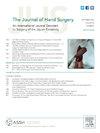镍钛诺压钉治疗拇指掌指骨融合的再手术率。
IF 2.1
2区 医学
Q2 ORTHOPEDICS
引用次数: 0
摘要
目的:镍钛诺技术提供了一种对骨折或融合部位进行压缩的低姿态方法。本研究的目的是评估镍钛诺钉用于拇指掌指骨(MCP)融合的再手术和融合率。方法:这是一项回顾性队列研究,由一名外科医生在2008年3月至2024年6月期间进行拇指MCP融合。用两根镍钛诺订书钉进行融合:每根订书钉位于与骨齐平的副韧带下方。收集患者的人口学信息、手部优势、手术指征、随访时间和再次手术的原因。结果:599例患者(女性503例,男性96例)697个拇指纳入分析对象。82个拇指进行了MCP与骨移植物的分离融合;615个拇指行MCP融合合并腕掌关节置换术。对于行腕掌关节置换术的患者,对中重度鱼际萎缩患者行MCP融合以增加捏紧强度。它也用于治疗MCP超伸大于30度、MCP关节炎或慢性副韧带不稳定。手术时的平均年龄为64.4岁。9个拇指(1.3%)因疼痛或突出的硬体而返回手术,7个拇指(1%)因MCP关节肌腱粘连而再次手术。x线片测定融合率,整个关节骨巩固,钉钉周围无透光;所有患者均在术后4 - 12周融合。临床随访的平均时间为9.6个月,而首次手术后硬体取出的再手术时间为31.3个月,粘连溶解的再手术时间为9.6个月。意外再手术的最低估计为2.3%。结论:使用镍钛诺连续加压钉进行掌指关节融合术,对于突出的硬体或粘连,融合率为100%,再手术率为2.3%。研究类型/证据水平:治疗性IV。本文章由计算机程序翻译,如有差异,请以英文原文为准。
Reoperation Rate in Thumb Metacarpophalangeal Fusions Using Nitinol Compression Staples
Purpose
Nitinol technology offers a low profile means of applying compression across a fracture or fusion site. The objective of this study was to evaluate the rate of reoperation and fusion using nitinol staples for metacarpophalangeal (MCP) fusions of the thumb.
Methods
This was a retrospective cohort study of thumb MCP fusions between March 2008 and June 2024 by a single surgeon. Fusions were performed with two nitinol staples: each beneath a collateral ligament flush with the bone. Demographic information, hand dominance, indication for surgery, length of follow-up, and reason for reoperation were collected.
Results
Five-hundred and ninety-nine patients (503 women and 96 men) with 697 thumbs were candidates for analysis. Eighty-two thumbs had an isolated MCP fusion with bone graft; 615 thumbs had MCP fusions in combination with a carpometacarpal arthroplasty. For patients having carpometacarpal arthroplasty, an MCP fusion was performed to increase pinch strength in those with moderate-to-severe thenar atrophy. It was also performed to address MCP hyperextension greater than 30 degrees, MCP arthritis, or chronic collateral ligament instability. The mean age at the time of surgery was 64.4 years. Nine thumbs (1.3%) returned to surgery for painful or prominent hardware, and seven thumbs (1%) had reoperation for tendon adhesions at the MCP joint. The fusion rate was determined radiographically with bone consolidation across the joint and no lucency around the staples; all patients were fused between 4 and 12 weeks after surgery. The mean time for clinical follow-up was 9.6 months, whereas for reoperation was 31.3 months for hardware removal and 9.6 months for lysis of adhesions after the initial surgery. The minimum estimate of unexpected reoperation was 2.3%.
Conclusions
Metacarpophalangeal fusion with nitinol continuous compression staples was associated with a 100% fusion rate and a 2.3% reoperation rate for prominent hardware or adhesions.
Type of study/level of evidence
Therapeutic IV.
求助全文
通过发布文献求助,成功后即可免费获取论文全文。
去求助
来源期刊
CiteScore
3.20
自引率
10.50%
发文量
402
审稿时长
12 weeks
期刊介绍:
The Journal of Hand Surgery publishes original, peer-reviewed articles related to the pathophysiology, diagnosis, and treatment of diseases and conditions of the upper extremity; these include both clinical and basic science studies, along with case reports. Special features include Review Articles (including Current Concepts and The Hand Surgery Landscape), Reviews of Books and Media, and Letters to the Editor.

 求助内容:
求助内容: 应助结果提醒方式:
应助结果提醒方式:


